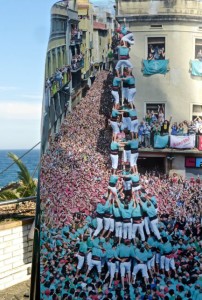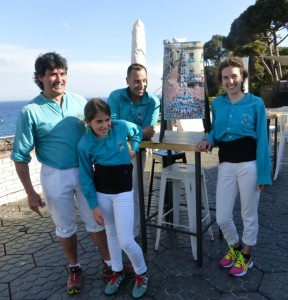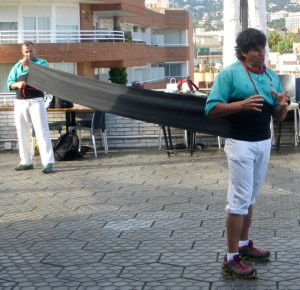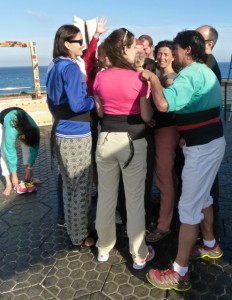Lessons in teamwork, pride and self-confidence

Imagine tightly wrapping a length of thick black cloth around your middle and then, firmly grounded, entwining arms-to-shoulders with the people next to you so others can scamper up your back. This is how you start to create a human tower or castell. It seems crazy, and yet this is the complex sport, the idea of fun, and the source of personal and civic pride for the castellers of Catalonia.
Of course no one could do it alone, which is the point. It is a team sport that takes skill, cooperation, focus and commitment. A 10-story tower, which I believe is a record height, requires a 1,000 castellers, each holding a specific position. Competitions between teams pack the town plazas of northeast Spain.
Although the tradition began more than 400 years ago near the city of Tarragona, it was not until about 50 years ago its popularity exploded in other parts of Catalonia, and in 2010 castells received UNESCO designation as Masterpieces of the Oral and Intangible Heritage of Humanity.
You’ve probably seen photos or videos of them – those crazy guys (and gals and children) who climb up each other. But there’s far more to their madness than meets the eye, as I recently learned in a demonstration and workshop for a group of travel bloggers attending the Travel Bloggers Exchange Conference (TBEX) in the popular seaside town of Lloret de Mar.
Understanding castells

We gather on the rooftop patio of restaurant/club Atica, with the glittering sapphire of the Mediterranean Ocean defining the beach cove below. On the rocky cliffs of this bit of Costa Brava (the “wild coast”), a stone tower from the 11th century rises from a precipice in the distance, reminding us of the long history of Catalonia. Before us stand two obviously-fit men, a slender young woman and a 10-year-old girl, the daughter of one of the men. The young woman named Neus, who looks like a teenager, tells me she is a 26-year-old architect, has been a casteller since age 10, and loves the “engineering aspects” of human-tower building.
Each is dressed in white pants and a teal shirt, the colors of the prestigious Castellers de Vilafranca, the large and well-respected association of 400+ members committed to preserving and promoting popular Catalan culture. Being a casteller is, for most, a sport in which to participate on weekends, competing against teams from other towns. But for Tony Bach i Lleal of Vilafranca, it is a full-time job.

Affable and clearly expert at explaining and facilitating the casteller experience, Toni has us begin by partnering to wrap the rolled black sash tightly around our waist and tuck in the end. Called faixa (pronounced “fascia”), sashes vary in length from 6 to 36 feet, depending on the casteller’s position inside the tower, and protects the back while giving climbers something to hold on to.
Next, Toni explains the goal: to successfully build and disassemble a castell without toppling. The assembly is complete once all castellers have climbed into their designated places, and the enxaneta (“enchaneta”, or the child who tops the tower) reaches the top and raises one hand with four fingers erect; a gesture said to symbolize the stripes of the Catalan flag. The enxaneta then climbs down the other side of the castell, after which the remaining levels of castellers descend in highest-to-lowest order until all have reached safety.
When I ask Toni’s colleague if he has any fear about his daughter being an enxaneta, he smiles – no doubt a common question – and says, “No. It is very safe, and an honor.”
Being part of a human tower
Having baffled this writer with complicated Catalan names for each position on the tower and the tower structures themselves, Toni calls the steps, like in a square dance, for his group of to begin demonstrating the actual methodology of shoulder mounting and dismounting. It is common for castellers to go barefoot to minimize injuring each other as they climb to their position, and for sensitivity when balancing.

Toni then invites members of the TBEX group to join in. While several are eager to climb, those, like myself, who opt not to give it a go, are positioned to form the pinya, or bottom base of the castell, to sustain its weight and act as a ‘safety net’ if the tower structure collapses, cushioning the fall of people from above. Fortunately, the climbers are agile and the pinva strong.
Clearly, success in completing a castell feels exhilarating, even as an on-the-ground part of the pinva. Understanding and experiencing a castell presents a fine lesson in personal confidence and team building, which Toni’s organization teaches to businesses and groups worldwide. If you ever get a chance to see them in action, do it. You will be amazed. You can contact him via http://castellersdevilafranca.cat/en/
